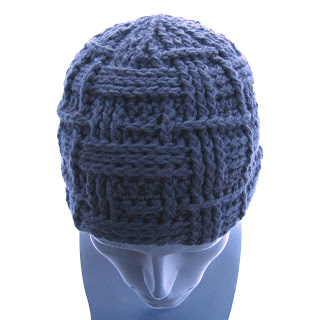Review:
The Open Weave - Crochet Pattern
I really like this pattern, however I had several issues with it. First off, I was never able to get my gauge correct. The pattern itself calls for a H (5mm) hook for a 22" head hat and to go up 1 hook size for a larger 23" hat. However even with a K (6.5mm) hook, my measurements were still coming out too small for the 22" size hat. I restarted the pattern about half a dozen times before just finally seeing what would happen using the K hook. I wanted to make a large hat, and with the K hook, I was successful, however the hat was way too short. I ended up adding 7 more rows to the hat, rows 12-18 to continue the pattern, which fit 3 men with heads 23-24" perfectly. The pattern is definitely not a beginner pattern. However, even with these issues I plan on buying more of this seller's patterns.Response:
I respond to this review here ONLY due
to the fact that many of the issues stated above are NOT TYPICAL,
logical, or explained fully and properly.
The instructions regarding sizing
clearly state:
“Follow the gauge to create a Medium
beanie. To create a Large or Small size, find the correct size
hook that allows you to meet the gauge
for a Medium. Then proceed with the suggestions listed
below. Take note that additional rounds
past round 25 will degrade the symmetry of the design
slightly, but may be necessary for
attaining the proper length. However, it is highly recommended
to create through round 25 with wool
fiber content and block to length.
”
Below this explanation in the pattern
is the recommendation to increase a hook size for a Large hat or
decrease the hook size for a Small hat. So that would necessitate
starting with a 5.0mm hook as I use, moving up to a 5.5mm, 6.0mm and
6.5mm, if necessary.
From what I have read in this review, a
Large hat (23” to 24” head circumference) was created with a
6.5mm hook, BUT the gauge could not be met for a Medium sized hat. I
cannot understand how this is possible. This is simply conflicting
with the logic of sizing and measurement. I do not understand this
statement in any way.
(Negating the above results and
assuming ONLY that a Large sized hat was created in a the typical
fashion of meeting Medium gauge and proceeding, I will continue my
discussion.)
With this information of success to
create a Large hat with a 6.5mm hook, it seems quite proper and
obvious to infer that the Medium gauge could be achieved properly
with a 6.0mm hook. With a simple count, this would mean that three
trial efforts (5mm, 5.5mm and 6.0mm hooks) were necessary and a
fourth try (6.5mm hook) produced the desired Large size hat.
Therefore, I cannot understand why it was necessary to restart this
hat around 6 times. And I can in no way understand the additional
problem with length - 7 additional rounds needed. It may be explained
in my discussion below of stitch size.
The diameter of the shaft of the hook
is meant to create loops that closely match that of the hook. It
creates the same size loop time and time again through the project.
This is the exact and only reason that different hook sizes have a
different shank diameter – to create different sized loops.
However, if yarn tension created by the non-working hand is high, the
hook size becomes irrelevant as all hooks taper down to the actual
hook (i.e. loops become smaller than the hook shank diameter and
therefore do not have much or any relation to the hook size with
which they were created.) Practice is the key to achieve properly
sized stitches in which the hook truly dictates the size of the
stitch. And as can be gleaned from the explanation above, proper yarn
tension is of utmost importance to achieve this very key aspect of
stitch sizing.
Also, this is a Beginner rated pattern,
and it is properly rated. As shown in the pattern skill level
description below, this is a statement that moderate skill is needed
to understand and complete this pattern. This probably means at least
6 months of consistent practice, but obviously depends on the
specific artist. I rate myself as an Expert - not on this scale. Only
Half double crochet, Front post half double crochet, and Back post
half double crochet stitches are necessary to complete this hat.
SKILL
LEVEL: Beginner (Easy, Beginner, Intermediate, Experienced)


























